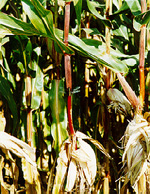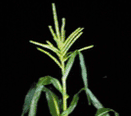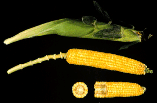|
There are many different types
of corn. Various breeds of corn have different genes that control
characteristics such as the height of the corn, how sweet the corn is,
and what color it is. Farmers choose corn that has genes that will produce
the kind of corn with the characteristics they want, like feed corn for
cattle, popcorn, or sweet corn. They also choose corn that have genes that
will do the best in the soil and weather conditions on their farm.
 |
What
genes would you choose to grow a type of corn where you live? |
|
 Dragonfly on a cornstalk
Dragonfly on a cornstalk
Photo by Emily Sprowls
|
 Corn is in the center of many farm ecosystems. Corn uses the nitrogen produced
by soybeans and other legume crops. Corn also
absorbs water and other nutrients in the soil
through its roots. Corn is eaten by the animals on
the farm, and humans eat both the animals and the corn.
Corn is in the center of many farm ecosystems. Corn uses the nitrogen produced
by soybeans and other legume crops. Corn also
absorbs water and other nutrients in the soil
through its roots. Corn is eaten by the animals on
the farm, and humans eat both the animals and the corn. 



